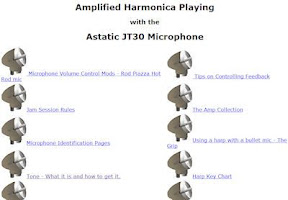JT30.com is Ten years old today.
2009-04-20 08:57:00
 I started the JT30 page back around 1994 as an AOL web page. I hand coded the page using notepad and tested it using Netscape Navigator. I originally put the page up as an advertisement for modifying and repairing JT30 mics. I found that I did not have the time to keep up with the orders so I stopped doing that. I collected lots of information about JT30s, Amplifiers and playing amplified Blues.
I started the JT30 page back around 1994 as an AOL web page. I hand coded the page using notepad and tested it using Netscape Navigator. I originally put the page up as an advertisement for modifying and repairing JT30 mics. I found that I did not have the time to keep up with the orders so I stopped doing that. I collected lots of information about JT30s, Amplifiers and playing amplified Blues.
At one point I shut the site down because I was getting so many emails and requests for information. I later started it up when the internet got larger and other people did the same kind of thing much better than I ever could.
In 1999 I registered the domain JT30.com.
I wrote a few music theory articles and tabbed out some simple riffs and I have been getting slow but steady traffic ever since. In recent years my life has become busy and other projects have taken up my time so I have not added very much to the site. I still play a little harp when I get a chance, but I never get to the jams and seldom find the time to go out to a show. I have tried to recruit guest bloggers, but so far there are only a few takers.
In a year or so I will retire and at that time I want to start working on the site again. I would like to tab out some of my harp favorites in greater depth like I did with Sonny Boy's Help Me. I want to give some step by step instructions for some of the mic mods that I do. I want to document some of the odd things that I've done with harp tuning. It will have to wait until I no longer have to spend my time making a living in hard economic times.
comments
2009-05-05 11:28:00
Keith
The astatic and cads used a different pin out. The standard xlr cable uses a floating signal to avoid hum. The high impdedance uses different pins and is just like a guitar cord and ignores one of the three wires. I am surprised that the mic works at all with a standard xlr cable.
Keith
2009-05-05 10:52:00
Bob L
Special cord? Are you speaking about the XLR mic cable that he plugs his mic into? The one that connects to our sound system snake on the stage? We use a good quality XLR cable for all of our microphones on the stage but have not heard of a high impedance cable. If that is true, I will make a trek to our local Guitar Center to get one as well.
2009-05-05 10:44:00
Keith
You have to take a pair of pliers and twist it off. You will have to wrap it with a few turns of some thick tape so that the pliers don't scratch it. Then you have to epoxy it back in place when you are done.
The noise often comes from a broken connection or a bad ground. These use a special cord and a normal xlr cord will not work. You need the High impedance cord that some harmonica stores sell.
2009-05-05 08:39:00
Bob L
Keith,
You sort of told me what I was hoping for. Since the XLR connection is glued in, do you have any suggestions on how to extract the connector in order to get at the solder connections on the pins?
2009-05-04 16:58:00
Keith
It does not sound like the element (it's a 151). It sounds like the cable. Or it could be the grounding. The astatic CAD was glued together and the connection breaks loose after a while. You might try re-soldering the connections inside and making sure that the cold side of the element is well grounded.
2009-05-04 16:52:00
Bob L
Hi Keith, I am not a harmonica player, but am a friend of someone I am trying to help out who owns a CAD HM50 VC. He plays harmonica at our church and is experiencing problems with the mic, in that it is providing a scratching static in addition to an otherwise clear strong signal. The element in this is an Astatic MC-127, with a paper label of MC151. I wired around the VC thinking the VC pot may be faulty, but no luck. Does this sound like a crystal that is broken and if so, can he replace the expensive MC151 with a ceramic of lesser cost?
Thanks
2009-04-27 04:08:00
Anonymous
Happy Birthday and please keep up the good work.
HarmonicaDylan
